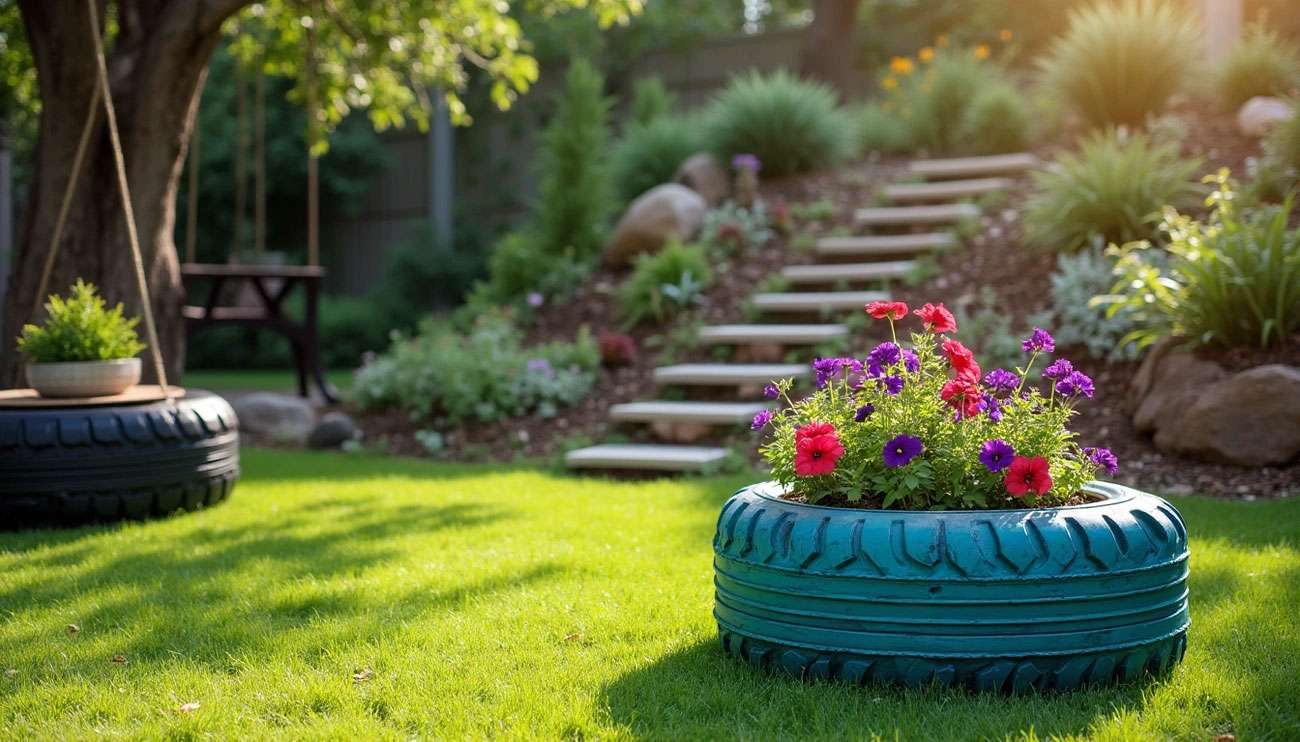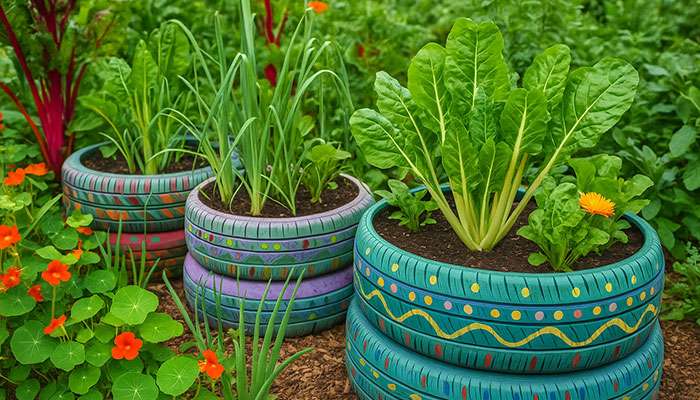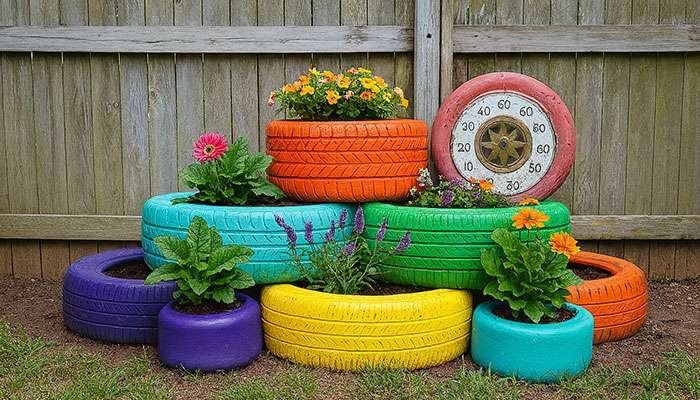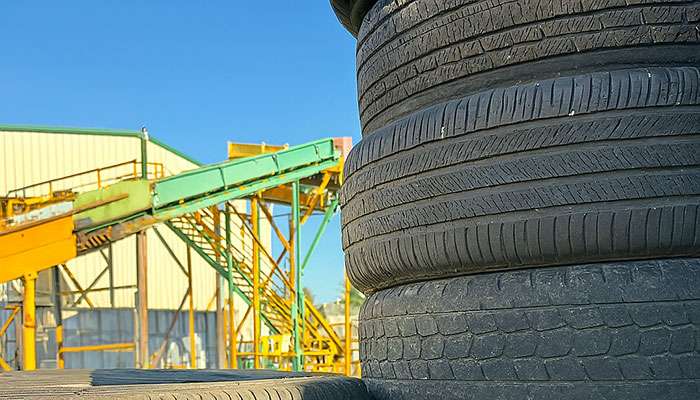
Old tires pile up faster than most people realize. The United States discards approximately 300 million tires yearly, with some estimates reaching closer to 400 million. That breaks down to more than one tire per person annually. These rubber circles can take nearly 100 years to decompose in landfills, creating a massive waste problem.
The situation has improved significantly through dedicated recycling efforts. Scrap tire recycling programs have reduced stockpiled tires by 94%. Today, about 90% of used tires undergo recycling. Many of these tires find new purposes in football fields, track surfaces, and creative DIY projects.
You don't need to contribute to the waste stream when better options exist. Old tires offer practical solutions for homeowners seeking functional additions to their property. We'll show you proven methods to repurpose these durable materials into useful items for your home and garden.
From simple weekend projects to smart disposal strategies, the following solutions can help you reduce waste while creating something valuable. These approaches save money and give your old tires a productive second life that benefits both your property and the environment.

Functional furniture and storage solutions don't require expensive materials when you have old tires available. These rubber circles provide the durability needed for everyday use while offering unique design possibilities that store-bought alternatives can't match.
Dogs naturally love the curved shape that tire beds provide. The rubber construction withstands heavy use while the circular design gives pets a secure nesting area. Here's how to build one:
The tire's interior creates a natural den-like space where dogs curl up comfortably. The raised edges work perfectly as a headrest or provide a secure spot for chew toys.
Tire furniture offers both style and hidden storage capabilities. Stack two tires together and secure them with bolts or adhesive for a sturdy coffee table. The real advantage comes from the removable top, which reveals substantial storage space inside.
For ottoman projects, wrap your cleaned tire with sisal rope, fabric, or burlap. Add a cushioned top that lifts off for accessing storage underneath. DIY enthusiasts report building these for under $73, while similar store-bought ottomans cost around $399.
Garden chairs from tires require strategic cutting to achieve proper comfort. Position the backrest at an 11-15 degree angle relative to the seat. For someone who's 6 feet tall, the backrest should measure 32-36 inches above the seat for adequate support.
Paint or fabric covering helps these chairs blend with your outdoor décor while maintaining their rugged durability.
Tire storage bins solve organization problems efficiently. Secure a wooden circle to the bottom of each tire, add casters for easy movement, and stack them for space-saving organization. The rubber material naturally grips surfaces, creating stable containers for toys, garden supplies, or seasonal storage.
Custom paint or decorative treatments help these practical containers complement your existing décor while providing years of reliable service.

Garden and outdoor spaces provide ideal locations for tire repurposing projects. These applications combine waste reduction with practical functionality for your landscape.
Transform worn tires into garden containers that catch attention and hold up to weather. Choose well-worn tires with a "sweet spot" that pushes in easily with your hand. Clean thoroughly with soap and a degreaser like Simple Green before applying paint. Light-colored paint reflects sunlight and keeps plants cooler, unlike black tires that absorb heat.
Cut the sidewall into petal shapes using a sharp knife and sidewalk chalk as your guide for a decorative appearance. Flip the tire inside out to create a flower-like container. Drill drainage holes and line with landscape fabric when placing on hardscape surfaces.
Proper installation ensures years of safe enjoyment from your tire swing. Select a healthy tree with a branch at least 8 inches thick for adequate support. Purchase rope rated for three times the combined weight of the tire and users.
Consider adding a swivel attachment to prevent rope twisting during use.
Sloped terrain becomes manageable with durable tire steps. Dig shallow indents in the slope and secure tires firmly into the ground. Pack soil or gravel around the edges for stability. The rubber surface provides natural grip that prevents slips on wet ground.
You can use whole tires or cut them in half depending on the slope angle and desired step height.
Large tires make excellent sandbox frames that require minimal construction. For a single tire sandbox, cut out one sidewall, attach a treated plywood base with screws, and fill with play sand. Multiple tires can be stacked and connected with bolts and washers for larger play areas.
Create a cover from plywood painted with chalkboard paint and add a doorknob handle to keep neighborhood cats from using your sandbox as a litter box.

When DIY projects aren't the right fit, proper disposal becomes essential. Several responsible options exist for removing unwanted tires from your property while supporting environmental goals.
Auto shops and tire retailers offer take-back programs that handle the recycling process for you. This convenient service typically includes a small disposal fee, which varies by location. Confirm this option when purchasing new tires to avoid separate trips and additional transportation costs. For most vehicle owners, this represents the most efficient approach.
Communities across the country host tire collection events through partnerships between local governments and environmental organizations. These events make proper disposal simple while ensuring environmental protection. Contact Earth 911 at 1-800-CLEANUP or visit their website to locate recycling facilities near you. Your local public works department can also provide guidance on nearby disposal options.
Retreading companies extend tire life by replacing worn tread with fresh rubber, reducing demand for new tire production. Late summer through early fall offers the best opportunity to sell used tires to these companies, as they prepare winter "snow caps" during this period. Retreading companies often pay higher prices during this seasonal demand increase.
Tires with substantial remaining tread can benefit other drivers. Check for at least 2/32 inches of tread—the minimum requirement for most applications. Use the penny test and examine tread wear bars to verify usability. Some retailers even offer credit toward new tire purchases when you bring in tires with reasonable wear.
The environmental consequences of discarded tires create problems that extend far beyond appearance. Smart repurposing delivers measurable benefits for communities and the environment.
Discarded tires occupy massive amounts of landfill space, taking hundreds of years to decompose. These non-biodegradable materials can consume up to 75% of available airspace in landfills. The methane buildup damages protective liners and contaminates groundwater. Tire recycling has successfully diverted over 110 million tires from landfills annually.
Abandoned tire stockpiles create serious safety hazards. Tire fires release dangerous chemicals including PAHs, benzene, and styrene. A single burning passenger tire produces over two gallons of oil. These fires burn for months and resist normal extinguishing methods.
Stagnant water collects in discarded tires, creating breeding grounds for disease-carrying mosquitoes that spread dengue, Zika, and malaria. Rodents nest in tire piles, potentially transmitting leptospirosis and salmonellosis.
Many communities offer free tire recycling events that reduce urban blight. Organizations like Bridgestone have supported over 1,050 community cleanup events, processing more than 300,000 collected tires. These programs provide practical solutions for proper tire disposal.
Tire recycling generates stable jobs throughout collection, processing, and manufacturing. Producing items from recycled rubber requires less energy than manufacturing new materials. Since creating one new tire consumes approximately 7 gallons of oil, repurposing saves valuable resources while reducing costs.
Old tires offer more practical solutions than most people realize. We've shown you proven methods to transform these durable materials into functional additions for your home and garden. From comfortable pet beds and storage solutions to garden planters and playground equipment, these projects deliver real value.
The environmental benefits make repurposing even more worthwhile. Every tire you save from the landfill helps address a significant waste problem while creating something useful for your property.
You have multiple options when it comes to handling unwanted tires. Tire shops typically accept old tires during replacement, while local recycling centers offer specialized disposal services. Tires with decent tread can find new life through retreading companies or help someone else through donation.
These repurposing projects let you exercise creativity while saving money. The satisfaction of creating functional items from waste materials provides its own reward. Whether you choose a simple planter project or tackle furniture creation, each effort contributes to reducing waste.
Ready to give your old tires a second life? Start with a project that matches your skill level and available time. Your efforts make a difference - both for your property and the environment. The next time you need to dispose of tires, remember these practical alternatives that can benefit you and reduce waste at the same time.
Transform waste into wonder with these smart tire repurposing solutions that benefit both your wallet and the environment.
• DIY projects offer endless possibilities: Convert old tires into dog beds, ottomans, planters, and storage bins for under $73 versus $399 store-bought alternatives.
• Proper disposal prevents environmental damage: With 300 million tires discarded yearly, recycling prevents toxic fires, groundwater contamination, and mosquito breeding grounds.
• Multiple recycling options exist: Tire shops accept old tires during replacements, local recycling centers host collection events, and retreaders pay for usable tires.
• Environmental impact is significant: Each repurposed tire saves 7 gallons of oil, reduces landfill waste, and supports the 90% tire recycling rate achieved today.
• Creative outdoor projects enhance your space: Build tire swings, garden stairs, sandboxes, and colorful planters that provide durability and unique character to landscapes.
By repurposing just one tire, you're contributing to a solution that has already diverted over 110 million tires from landfills annually while creating functional items that can last for years.
Old tires can be transformed into various useful items such as dog beds, ottomans, planters, and storage bins. These DIY projects are cost-effective and can add unique character to your home and garden.
There are several responsible options for tire disposal. You can leave them at tire shops during replacements, find local recycling centers that accept tires, or donate usable tires to retreading companies. Many communities also host special tire collection events.
Yes, repurposing and recycling tires have significant environmental benefits. It reduces landfill waste, prevents toxic tire fires, and conserves resources. Each repurposed tire saves about 7 gallons of oil and contributes to the current 90% tire recycling rate.
Old tires can be used to create various outdoor projects such as tire swings, garden stairs, sandboxes, and colorful planters. These projects not only repurpose the tires but also add durability and unique character to your landscape.
While old tires can be used as planters, it's important to be cautious. Tires can leach chemicals into the soil over time, potentially affecting plant health and safety for consumption. If you choose to use tire planters, consider lining them and using them for non-edible plants.